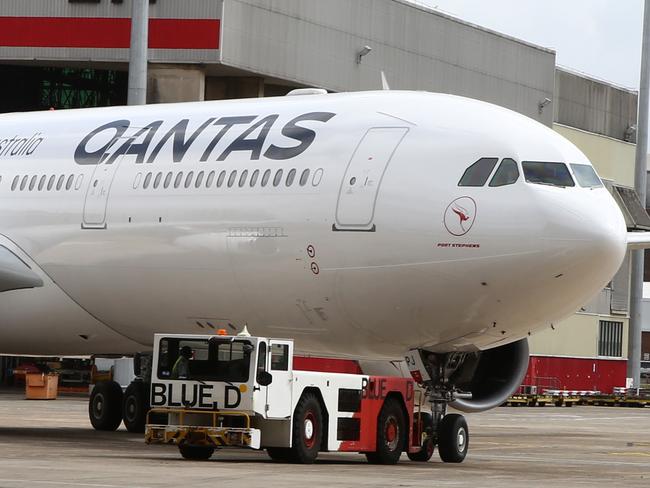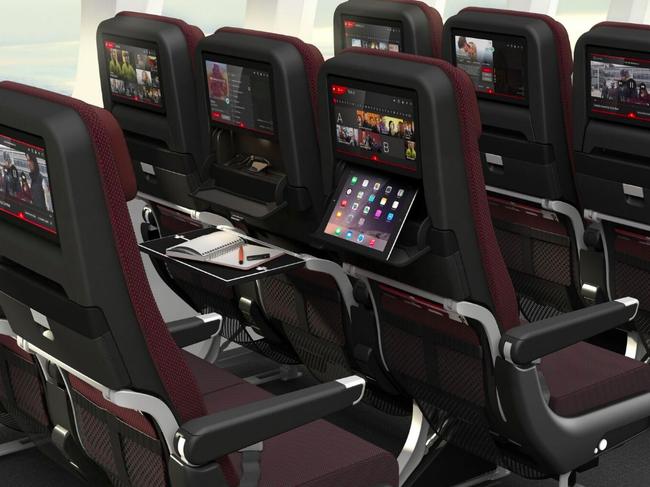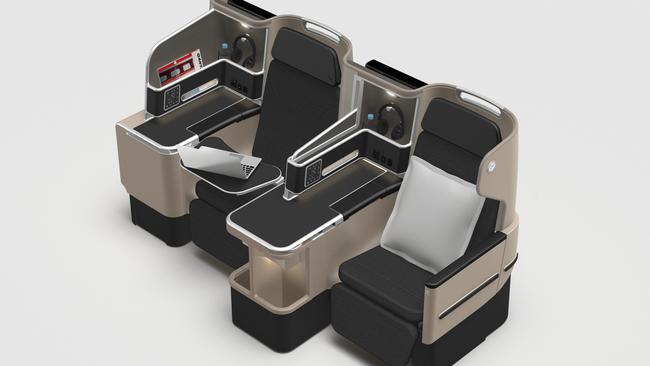Qantas unveils extra, precious inch of legroom on Dreamliners
Qantas has updated its kangaroo logo and signage as it delivers extra space in economy on new Dreamliners.

Qantas has revamped its kangaroo logo and streamlined its typography as it gives more room to economy customers on its new fleet of Boeing 787-9 Dreamliners.
The new “streamlined” look for the iconic logo, announced by Qantas CEO Alan Joyce today, comes ahead of the introduction of the Dreamliner fleet a year from now.
The change is only the fifth time the red-and-white image on the tail of Qantas aircraft has been updated since it was first introduced in 1944. The last update was in 2007.
The new design sees a more streamlined kangaroo, which has had its paw removed and shading added to give it more depth.
Kangaroos have also been added to the nose of the plane and to its winglets.
The Qantas typography has been changed to make it more modern and Qantas planes will also have the airline’s name on their bellies for the first time.
“We wanted to make sure our brand remained familiar but we also wanted it to be more modern and dynamic like the 787 and like Qantas,” said Mr Joyce.
Qantas unveiled the changes on one of its A330s after two weeks of repainting in the Mojave Desert in the US.
“This has been one of our biggest ever corporate secrets,” Mr Joyce said.

The new paint job will be gradually added to Qantas’s fleet and completed by 2020.
“This new brand is more streamlined and the shading behind the kangaroo gives a better sense of movement and depth,” said designer Marc Newson.
“A silver band now extends from the tail to the rear of the fuselage, to give a more premium feel.
“The typography for the word Qantas, which measures almost two metres high on the 787, has been carefully streamlined.
“And Qantas will appear on the aircraft’s belly, so you can tell when it’s the national carrier flying overhead,” Mr Newson added.
In another link to the airline’s heritage, the classic winged kangaroo that appeared on tails across three decades will feature under the cockpit window and incorporate the individual name of each aircraft.

Meanwhile Qantas has unveiled the long-awaited seat configuration for its Dreamliners, revealing that economy customers are set to get an extra, precious inch of legroom compared to seats on its Airbus A380 superjumbos.
But the airline will keep customers guessing on exactly where its new jetliners will fly, saying it will reveal those routes — expected to be either Sydney to the US or Perth to London — in coming months.
The airline plans to use the fuel-efficient twin-engined jets to replace some of the routes that its 747 fleet has flown.

Qantas has eight of the long-range 787-9 aircraft on order to replace its ageing 747 jumbo jets. Four will be delivered in the 2017-18 financial year and four more in the year after.
The new Dreamliners will feature 236 passengers across Business, Premium Economy and Economy cabins in a layout that Qantas says has been designed to maximise comfort for the longer distances the 787-9 is expected to fly.
“The Dreamliner is an aircraft built for comfort. The windows are bigger, it helps reduce jet lag, it’s extremely quiet and there’s a system that smooths out turbulence. Customers are going to love it,” said Qantas chief Alan Joyce.
“We’re planning to make the most of the 787’s amazing range, so we’ve designed the cabin to give Qantas passengers a better experience on long haul flights.
“Many of the cabin design elements reflect what our customers have told us. Personal storage rates really highly, so we’ve created extra space in Economy for customers to store their personal devices and water bottles.
Laid out in a 1-2-1 configuration, each business class seat comes with direct aisle access as well as a fully-flat bed stretching out to 80 inches.
The business class seat — which will have a width of 24 inches — will also come with a 16 inch touch screen, a new deployable privacy divider and a reclined position from takeoff to landing.

The 166 economy seats will come in a 3:3:3 configuration with each seat having a pitch of 32 inches (compared with 31 inches on the A380), a width of 17.2 inches and 6 inch seat recline.
That seat will also feature a new personal device holder and USB ports; more storage areas; a seat-back mood light designed to minimise disturbance for other passengers; and a 12-inch high-definition entertainment touchscreen.
The Dreamliner’s Premium Economy cabin will be unveiled in early 2017.
Japan Airlines flies its long-haul 787s with 195 seats: 44 in business class, 35 in premium economy and 116 in economy. Air New Zealand, which also flies Dreamliners, has configured its 787s with 302 seats, to 18 in business class, 21 in premium economy and 263 in economy.
Details on Qantas Dreamliner destinations will be revealed in coming months, with the first international flights on sale before Christmas.





To join the conversation, please log in. Don't have an account? Register
Join the conversation, you are commenting as Logout